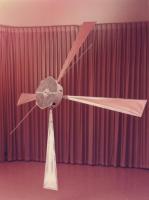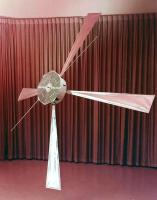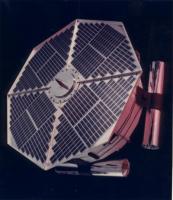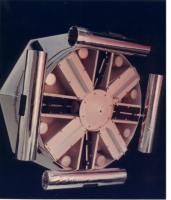Printable Version of Topic
Click here to view this topic in its original format
Unmanned Spaceflight.com _ Sun _ Small solar probe Sunblazer
Posted by: Stranger V May 21 2006, 09:19 PM
Small solar probe Sunblazer. Who know something more? Thanks
Posted by: djellison May 21 2006, 09:26 PM
Do you mean Sungrazer?
Posted by: Stranger V May 21 2006, 09:32 PM
No. Sunblazer - sure.
Small Interplanetary Probe Project - Sunblazer.
Posted by: djellison May 21 2006, 09:34 PM
Well - the only reference to that I can find is on this page...
http://www.lib.rpi.edu/dept/library/html/Archives/access/inventories/87-12/87-12_Series_VII.html
Doug
Posted by: Stranger V May 21 2006, 09:39 PM
I had find this reference also
![]() But I need some more...
But I need some more...
Posted by: BruceMoomaw May 21 2006, 11:56 PM
A little dinky thing (or several of them) briefly proposed around 1967 to be put into solar orbit for the sole purpose of transmitting dual-frequency radio signals through the solar corona to allow radio-occultation profiles of its structure. Congress quickly squelched funding for it. It would, I believe, have been small enough to be launched into solar orbit by a Scout. I'll look (briefly) to see what else I can find -- all I have up to now is a few brief references from the "Aviation Week" and "Technology Week" issues of that year.
Posted by: BruceMoomaw May 22 2006, 12:08 AM
Moomaw triumphs again! Here we are:
http://ntrs.nasa.gov/archive/nasa/casi.ntrs.nasa.gov/19650023156_1965023156.pdf
http://ntrs.nasa.gov/archive/nasa/casi.ntrs.nasa.gov/19660010374_1966010374.pdf
http://ntrs.nasa.gov/archive/nasa/casi.ntrs.nasa.gov/19660021471_1966021471.pdf
http://ntrs.nasa.gov/archive/nasa/casi.ntrs.nasa.gov/19660028032_1966028032.pdf
http://ntrs.nasa.gov/archive/nasa/casi.ntrs.nasa.gov/19660030042_1966030042.pdf
http://www.osti.gov/bridge/servlets/purl/9723-aAKsUP/webviewable/9723.pdf (pg. 36-46)
http://www-tech.mit.edu/archives/VOL_088/TECH_V088_S0527_P001.txt
http://www-tech.mit.edu/archives/VOL_087/TECH_V087_S0070_P003.txt
Congress actually briefly started to fund the thing before cancelling it.
The very last reference explains something that puzzled me in the one photo of the thing I remember seeing: it had something like an aluminized folded umbrella fastened to one end. It turns out that this was a solar sail that it would have used to keep itself aligned in attitude. (There's also one 1966 NASA document which I can't obtain, but whose title suggests that they might have been planning to add more instruments to it -- specifically, a "solar wind deuterium detector and charge spectrum analyzer".)
Posted by: Stranger V May 22 2006, 01:52 AM
Thanks!!! ![]()
Posted by: Paolo Aug 3 2006, 12:14 PM
I have most of the documentation produced by NASA and the MIT on Sunblazer because I hope to write an article on it sometime.
Attached is a picture of the Sunblazer mockup in the final (1969) configuration
Posted by: dilo Aug 3 2006, 04:53 PM
Ciao, Paolo. Welcome to the Forum! ![]()
Interesting probe, especially for solar sail application!
The picture appear aged, I made a simple color adjust and sharpening to better show it's real aspect (I guess)
Posted by: Paolo Aug 3 2006, 05:18 PM
Ciao!
These are the front and back of Sunblazer with the solar sail coiled
Posted by: dilo Aug 4 2006, 08:36 AM
These are the front and back of Sunblazer with the solar sail coiled
How the reflective wings are doployed? Inflatable tubes?
Posted by: Paolo Aug 4 2006, 10:42 AM
According to the document MIT CSR TR-69-1 "The conceptual design of a Small Solar Probe (Sunblazer)":
"Sail is fabricated with aluminized mylar which is stretched between two longerons of prestressed spring-steel tape and stiffened by a cross frame rod at the extremity"
"Sail storage is accomplished by winding the sail from its base toward the vertex on a 1 1/4 in diameter pipe. This action causes the longerons to form an overlapping, bifilar helix spring, which has sufficient stored energy to deploy a test sail to the flight position against a 1 g load"
Posted by: Paolo Aug 4 2006, 10:45 AM
This is the entry on Sunblazer from my forthcoming two-volume book "Robotic Exploration of the Solar System"
An unflown NASA project for a solar probe was Sunblazer, developed from the mid-1960s in cooperation with the Massachusetts Institute of Technology (MIT). The idea was to develop a family of very small probes (4.5 kg being the initial objective) to be launched often by inexpensive solid fueled rockets in orbits that would take them to a close solar conjunction in a short time. While prospectically close to the Sun, Sunblazer would use a 500 W peak power dual-frequency radio transmitter to probe the corona in order to determine the density of electrons, to probe the solar magnetic field by measuring the rotation of linearly polarized radiowaves and to detect fluctuations using a coded signal, so that the time of flight of radiowaves could be accurately measured.
In the first design iteration, the spacecraft would consist of a simple cylindrical payload capsule using a small four-bladed solar sail to stabilize its attitude to the radial direction of the Sun and a solar panel to provide up to 12 W of power at aphelion or up to 30 W at perihelion. The spacecraft, a full-scale working model of which was built at MIT, would not require an active temperature control system even at perihelion and would not include booms other than two simple whip antennae.
The mission profile required that the spacecraft enter a solar orbit with perihelion at 0.53 AU and period of 0.67 years, so that exactly one year after launch it would be at perihelion and in solar conjunction.
During subsequent design iterations, consideration was given to add some piggypack instruments, and the mass of the spacecraft reached 18 kg.
The first Sunblazer was expected to be launched in 1968 by a five-staged all solid propellant Scout C rocket from the rarely used Wallops Island launching range, on the Atlantic coast of Virginia, with twin probes to follow in 1969 and 1970. The project was eventually terminated in the late 1960s.
Posted by: dilo Aug 4 2006, 04:57 PM
Thanks, Paolo.. really interesting! Is incredible to see they planned a so miniaturized device 40 years ago.
And with solar cells + solar sail attitude, the only constraint to the spacecraft lifetime is the hardware reliability!
Powered by Invision Power Board (http://www.invisionboard.com)
© Invision Power Services (http://www.invisionpower.com)




